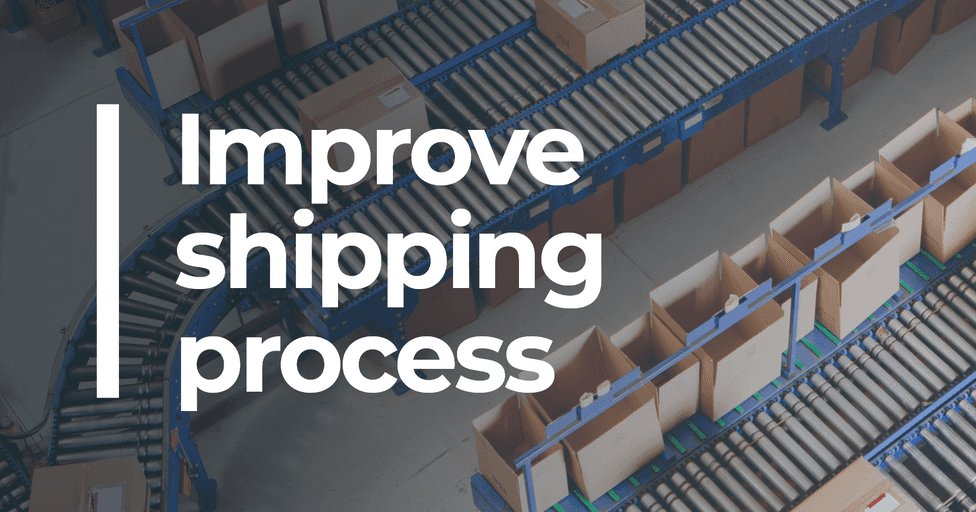An efficient shipping process is key to the profitability of many businesses. From annoying delays to products arriving damaged, improving this process will significantly reduce incidents and increase customer satisfaction.
How can you optimize your shipping? Fortunately, software such as Outvio makes advanced features available to retailers to improve shipping processes quite easily. Let's see which strategies are the most effective.
Why you should optimize your shipping process
Shipping processes are a crucial point of contact between the company and the customer. They play a fundamental role in the customer's perception of the brand.
Improving shipping processes ensures that products reach their destination in the right time and manner, minimizing mishaps and negative customer experiences.
In contrast, inefficient shipments generate losses and a bad reputation: 53% of customers have canceled or abandoned their purchase because delivery was too slow.
By optimizing your deliveries, you will:
- Satisfy customers with on-time delivery and impeccable products
- Strengthen your brand with reliable shipping service
- Reduce operating costs by eliminating inefficiencies
- Build loyal and repeat customers
- Increase your sales
How to improve your shipping process: best practices
1. Encourage communication
Communication is at the heart of the shipping process. Internally, your shop, warehouse, and carriers must coordinate to schedule deliveries or pack products. Externally, you must always keep customers informed about the status of their order. Therefore, if you want to improve your shipping process, the first step is to ensure good communication flow between all parties involved.
You can achieve this in many ways:
- Investing in your own shipping management platform: This will allow you to centralize the communication and tracking of all shipments in one place.
- Using specialized software: There are different software solutions that can help you automate communication with your customers, carriers, and warehouses.
- Harnessing the power of transport APIs: Transport APIs allow you to connect to your carriers' systems to get real-time information on the status of your shipments.
2. Work with several transport companies
Relying on a single carrier is quite inefficient, as you will be limited to its shipping methods and you will not be able to meet your customers' demands if they want a type of delivery that it does not offer. This can lead to lost sales.
By contrast, working with multiple carriers will allow you to create a shipping policy with a variety of delivery options and ensure greater flexibility.
In addition, companies that ship with multiple carriers can save up to 36% in shipping costs compared to those that only use one.
There are two main reasons for this:
- They can negotiate cheaper shipping rates by having a higher volume of shipments and by being able to compare prices between different carriers.
- They can switch carriers depending on how cost-effective it is for each order. This allows them to take advantage of the best deals and avoid paying excessive rates for shipments to certain destinations or with specific characteristics.
3. Ship from multiple warehouses
If your business spans different regions, shipping from a single location can be very inefficient. Large companies must divide logistics distribution into strategically located warehouses.
By having geographically distributed warehouses, delivery times are significantly reduced. This is because products can be shipped from the warehouse closest to the customer, eliminating long distances and optimizing the distribution process.
This also gives you greater flexibility to handle peak demand, seasonal fluctuations, or unexpected events. Remember that if you are shipping from multiple warehouses, you will need to perform regular inventory updates to ensure that stock is available to fulfill orders.
4. Use shipping rules
Establishing allocation rules within your order management system is a fundamental step in improving your shipping processes.
These rules allow you to automate the selection of the most appropriate shipping method or carrier for each order, based on the criteria of your choice.
For example, you can
- Prioritize that the shipment always leaves from the nearest warehouse
- Select a specialized carrier for heavy shipments
- Use more secure shipping services for high-value orders
- Simply choose the carrier with the most economical rate
Allocation rules are especially useful when you work with several carriers, as you can put your business on autopilot and be sure that orders are always handled efficiently.
5. Improving shipping processes within the warehouse
According to Statista, US e-commerce companies that want to improve the shipping process focus their efforts on the warehouse. After all, important shipping processes such as picking, packing, and labeling take place in the warehouse. If you don't optimize these, your order processing will be slowed down, and increased costs are inevitable.
How can you optimize shipping processes within your warehouse? Let's look at some key strategies:
- Implement a clear identification system: Assign a unique and identifiable SKU (Stock Keeping Unit) to each product. Then place each product in a specific location within the warehouse, following a logic that makes it easy to locate quickly and accurately
- Use digital picking lists to guide operators in picking products, optimizing their route, and minimizing search times
- Implement specialized software for printing shipping labels, streamlining order preparation, and minimizing manual errors
- Use barcode or RFID scanning systems to automatically check the items in each order, ensuring that the correct products are packed and avoiding mix-ups
- Implement weight and dimension control systems to detect discrepancies and prevent shipping errors
6. Send personalized shipping notifications
Personalized shipping notifications are an essential tool for improving your shipping processes.
They keep shoppers informed at every stage of the process, from order confirmation to final delivery, generating greater satisfaction. It is recommended that you automate the sending of these notifications on your customers' preferred channels (email, WhatsApp, or SMS).
Personalize shipping notifications with the customer's name, order number, and product details to add a more personal touch. Remember that 71% of customers expect personalized communications from the brands they shop with.
Some additional tips:
- Send different types of notifications to different groups of customers, based on their preferences and shopping behavior
- Include a discount code or special offer to increase your sales
- Send an email asking the customer to leave a review of their shopping and shipping experience
7. Improve your shipping documentation generation process
Shipping documents are essential elements of logistics and international trade, providing crucial information about their origin, destination, contents, and value.
Errors in shipping documents can lead to delays in customs clearance, fines, and even seizure of goods.
How to improve the shipping document creation process:
- Automate document generation using specialized software to quickly, accurately, and consistently create documents
- Ensure your team is trained in the proper preparation of shipping documents
- Establish a rigorous review process for all shipping documents prior to shipment, verifying that information is complete
Improving the document creation process is essential if you are shipping internationally.
8. Optimize the packaging of your shipments
Proper packaging is essential to prevent damage to shipments, but it also comes at a significant cost. Finding a balance between packaging quality and cost can help you minimize shipping costs without compromising the integrity of your shipments. It is important to make sure you use the most appropriate boxes for each product.
They should not be too large, but not too small either. Perform quality checks and inspect packaging for problems before shipping. If the product is fragile, use absorbent packaging materials to cushion shocks and prevent damage.
9. Analyze the performance of your shipping operation
Regularly analyzing the performance of your shipping process allows you to identify areas for improvement and take corrective action. With Outvio's analytics system, you can monitor your carriers' transit time, their incident rate, shipping costs, the efficiency of your support agents, or any data related to returns. These are some of the best practices related to analytics that will help you build a more robust shipping process:
- Compare the performance of different carriers, logistics operators, and other shipping service providers to identify the most efficient ones
- Investigate the causes of late deliveries, damaged goods, and returns to implement preventative measures
- Look for areas where you can reduce costs, such as optimizing shipping routes, negotiating better rates with suppliers, or implementing more efficient processes.
- Get direct feedback from your customers about their experience with the shipping process to identify areas for improvement
- Monitor incidents in a control tower like Outvio's to understand the problem and provide an immediate solution
10. Integrates a returns portal with automatic exchanges
It's not just shipping that's important to your business; returns also play a crucial role. In fact, ensuring a good returns experience often makes the difference between losing a customer and gaining a loyal following.
Investing in a returns portal with automatic exchanges, like the one provided by Outvio, is a smart decision that can significantly improve the customer experience, optimize your business, and strengthen your brand image.
The returns portal should be integrated with your order management system so that returns information is updated automatically. This will allow you to have a complete overview of the returns process and make informed decisions.
How will the returns portal improve your shipping process?
- You will be able to design a flexible return policy that encourages purchasing.
- Your customers can manage the entire returns process themselves without consuming resources.
- You will be able to promote revenue retention by offering in-store credit and encouraging automatic product exchange.
Conclusion
Optimizing the shipping process is crucial to providing a smooth and satisfying shopping experience for your customers. Implementing the strategies described in this article, such as task automation and personalized communication, will undoubtedly help you improve the logistical efficiency of your shipping process.
However, to achieve a higher level of optimization, the incorporation of specialized shipping software is a critical step.
Shipping software allows you to centralize and automate all shipping-related tasks, from label generation to delivery tracking and returns management. It's indispensable if you want to be more efficient with your shipments.




